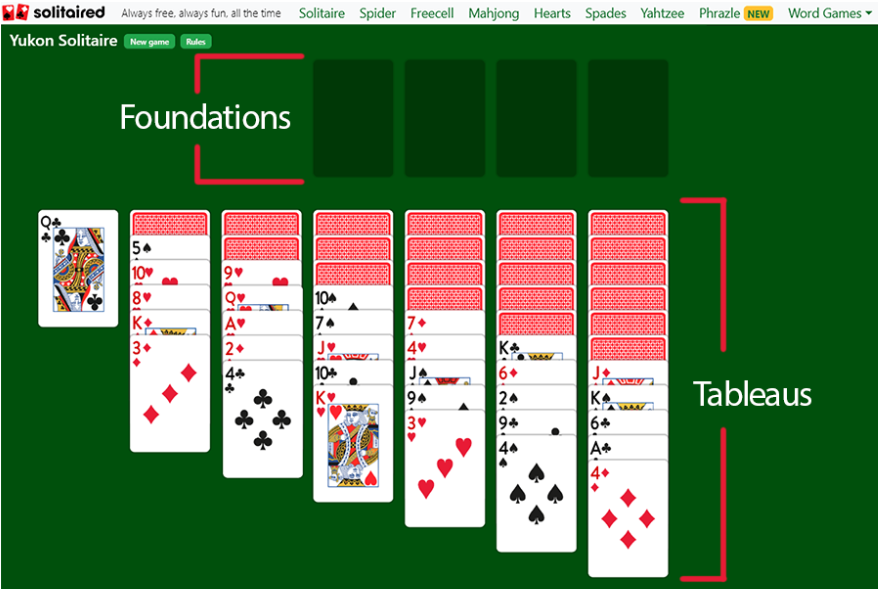Play Yukon Solitaire Online For Free
Play unlimited games of Yukon Solitaire. Play our game of the day to compete on the leaderboard, and use hints and undos to help you win the game.What is Yukon Solitaire?
Yukon is a variation of Solitaire played with 52 cards where you move groups of cards regardless of their order. This makes it fundamentally different from Klondike. Unlike most Solitaire games, Yukon solitaire doesn’t have a stock or waste pile.How to Play
Object
The goal of Yukon solitaire is to move all cards from the tableau into the 4 foundation piles, by suit, from ace to king.
Setup and Play Area
Yukon solitaire starts out with 7 tableau piles in the following arrangement: 1 in the first pile, 2 in the second pile, etc. The top card of each pile is flipped face-up. Then every pile except the first is dealt an additional 4 face-up cards. The first card is its own tableau.
There are two main areas in the game:
- Foundation piles: These are the empty piles at the beginning of the game. You’ll build them up as you go, usually starting with aces.
- Tableau piles: These are the workable piles on the table. They are shuffled and dealt before the card game starts.

Rules and Available Moves
Yukon plays much like regular Klondike solitaire, but with a few important alterations to gameplay.
- Tableau card sequences are built with alternating colors.
- You can move stacked cards in the tableau regardless of their order, as long as the bottom card you’re moving is one rank below and of the opposite color of the card you’re moving it on top of. For example, if the top card of a tableau pile is a black queen and another pile has a red jack under a number of cards you can’t move yet, you can move that stack, starting with the red jack, onto the black queen. This is the rule that makes Yukon unique.
- Only kings can be moved into empty tableau columns.
- Foundations must be built by suit in ascending order, for example, from Ace of Spades to King of Spades.
- You can move cards from a foundation pile to a tableau pile, so strategic backtracking is allowed.
Strategy
Going in with a strategy will both increase your odds of winning and make the game more enjoyable. Here are a few tips to get you started.
- Take your time. If Yukon is a new game variant for you, it may take some time to get used to how movement works. Look carefully at every card before making moves, not just the top cards. You just don’t want to miss any possibilities.
- Try to empty tableau piles quickly. The faster you can reveal the face-down cards, the faster you can strategize moving them to the foundations.
- Use aces as soon as they become available. Aces begin all foundation piles, so use these once they become available.
Frequently Asked Questions
What is the difference between Yukon and Klondike solitaire?
Klondike is one of the easier variants of Solitaire. It’s easy to pick up and a great stepping stone to other variants. But what makes it different from Yukon variants?
In Klondike, cards can only be moved from a tableau column if they form a proper sequence. Alternatively, Yukon allows you to move groups of cards from a tableau column if they are not packed in sequence. As long as they form a descending sequence and color, then you can make the move.
There’s also no stock or waste pile in Yukon, making the game a little bit more difficult.
The goal of both games stays the same: build up four foundation piles in order from ace to King, all of which follow the same suit.
What are the odds of winning Yukon solitaire?
When looking at 626,953 random games played, 85,856 were won, making the win rate 13.69%.
How many types of Yukon variants are there?
There are dozens of variations of Yukon solitaire. Some of our favorites are Alaska, Queenie, and Scorpion Solitaire.
If you're looking for something outside of Yukon Solitaire, you can always play classic online Solitaire or Klondike. For harder variations similar in level to Yukon, try Spider Solitaire or FreeCell.
Is Yukon Solitaire hard?
Yukon solitaire is more challenging than other variants, including Klondike, mainly because there is no stock or waste pile, and you must be extra patient to win a game.
